A fairly ordinary looking newspaper wrapper introduced me to an extraordinary man with many facets to his life: apothecary, bankrupt convict, advertising genius, quack, patent medicine merchant and philanthropist. My interest was sparked by 2 newspaper wrappers that appeared on eBay auctions, and little did I suspect where my research would take me. The first wrapper was an example of the 1885-99 ½d Fergusson & Mitchell Victorian wrapper that was issued in four colours (sequentially grey-lilac, pink, yellow-orange and green) over that time period. Although the Type 2 barred numeral ‘207’ of Kerang was undated, this pink version was issued on or after January 1887. Another point of interest was that the 2-line address was sufficient for the newspaper to be delivered (Figure 1).
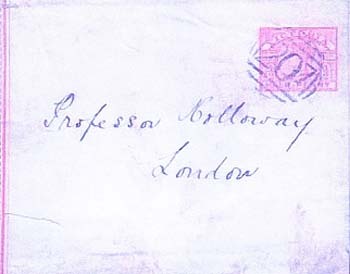
The second, a N.S.W. wrapper addressed to Professor Holloway, C/o Gordon & Gotch, Melbourne prompted me to email the company in Melbourne to see if they had any information as to the purpose of Holloway’s visit to the company in 1896. I never received a reply, and subsequent events provided conclusive evidence that Gordon & Gotch were acting as an intermediary for Holloway’s advertising in Australian, particularly Victorian, newspapers (Figure 2).
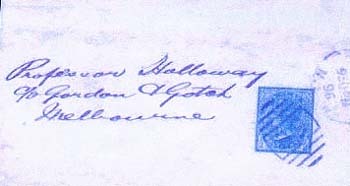
Who was Professor Holloway, how could such a limited London address find him, and what association did he have with the Australian Colonies? The dates of these wrappers delayed my eventual identification of Professor Holloway and his ‘alter ego’, for the “Professor’s” death predated the covers. Recourse to my Encyclopaedia Britannica (1967) found a short entry worth quoting in its entirety:
“Thomas Holloway b. Sep. 22, 1800, Devonport, Devonshire – d. Dec. 26, 1883, Tittenhurst, Berkshire, patent-medicine merchant and philanthropist. In 1837 he began to sell an ointment that carried his name around the world, and soon added the sale of pills to his business. Advertising played a large part in his business, and from his wealth he endowed two institutions – a sanatorium for the mentally afflicted of the lower middle class, opened in 1885, and a college for women, opened in Egham in 1886”. An engraving by an unknown artist was included. Subsequently, additional biographical data was obtained from the prestigious British medical journal “The Lancet”: “The son of Cornish innkeepers, Holloway trained as an apothecary in Penzance, and migrated to London to make a multimillion pound fortune.”
Even after finding the Professor Holloway 1857 and 1858 Halfpenny Tokens on an Australian internet coin site, I was not convinced that Thomas Holloway and the “Professor” were one and the same man. The obverse of both tokens was identical. The reverse of the 1857 and 1858 were identical except for the appropriate date below the central figure of the seated goddess of Health, Hygeia . The engraving in the encyclopaedia and on the token bore little resemblance, except for a mid-nose bump. Large numbers of the tokens were sent to the Australian Colonies, particularly to Victoria and it was said that they were used as coins of the realm on the Victorian gold fields (Figure 3).
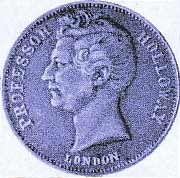
I proceeded with the assumption that Thomas and the “Professor” might be one and the same man, but I found nothing on the internet stated that this was a fact. I even felt that there was some reluctance on the part of the Royal Holloway at the University of London (RHUL) to admit to this relationship. Thomas began selling his pills in England in 1837 (it is claimed that the ointment was first made in his mother’s kitchen using her pots and pans); he was recorded as having a period of bankruptcy and incarceration in a debtor’s prison; and the pills remained on sale throughout the world until the early 1900’s.
The business was carried on after Holloway’s death by a brother-in-law who added the Holloway name to his own (Henry Driver-Holloway). Another brother-in-law (George Martin-Holloway) followed suit with his name and continued Thomas’ philanthropic endeavours. This accounts for the continuance of the Professor Holloway name on mail after his death in 1883. The business was eventually sold, after going into decline, to Beecham’s Pills in 1930.
Before describing Holloway’s claims for his pills and ointment, his recognition as an advertising genius, as well as his philanthropic benefactions, I will describe 3 additional examples of Holloway philatelic interest:
1. Prior to the advent of commercial use of perfins, Holloway produced overprints on English definitive stamps. I have seen 3 examples of the ‘HOLLOWAY/244’ overprint on the1d rose-red Queen Victoria stamp (S.G. 40, issued 1856), the overprint being blue in each instance. The overprint was said to have been used at 3 different addresses for the firm – 244 Strand, 113 Southwark Street, and 533 Oxford Street, London (Figure 4).
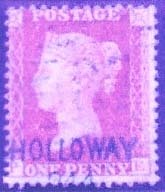
2. A copy of a blue United States Internal Revenue stamp of 1 cent denomination, Holloway’s Pills and Ointments above an eagle, with 80 Maiden Lane, New York below (Figure 5).
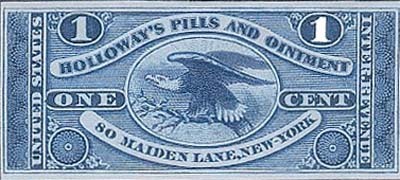
3. A 1906 Collie W.A. Holloway advertising envelope states “EVERY GOOD NURSE USES & RECOMMENDS HOLLOWAY’S Pills and Ointments”. It mentions that the pills and ointment composition has always remained the same, but, see later (Figure 6).
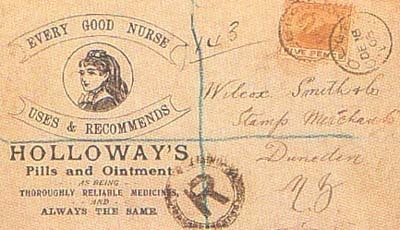
Holloway’s advertising genius was the source of the vast sums of money donated to his philanthropy. He and his wife had no children and he consulted his wife in regards to how his fortune should be endowed. Before proceeding to outline his remarkable world-wide advertisements, a short discussion of the pills and ointment are relevant to this story.
The recipes for the pill and the ointment were a profound secret until after Holloway’s death and I have seen different ingredients described for both. I will list the ingredients as described in the medical journal “The Lancet” of June 9, 2001. “The ointment was largely beeswax and lanolin, and the pills aloes, ginger and soap. Their huge popularity and profitability can be ascribed less to their ingredients than to Holloway’s enormous expenditure on advertising (£5,000 a year in 1842, rising to £50,000 in 1883) and to his ingenious promotional methods.” It should be added that Queen Victoria was a devotee of his pills, so this could have been of help in his promotions, although he never received the Royal Warrant as the Apothecary to the Queen.
The tokens, the stamp overprints and the advertising envelope were relatively minor forms of his advertising. Thomas Holloway’s goal was to advertise in all the languages known to man in the 19th century, and it was recorded that package inserts were available in several languages including Chinese, Persian and Armenian. The frequency and the role of newspapers (containing his advertisements) posted in Victorian wrappers addressed directly to the “Professor” in London or indirectly to Gordon & Gotch was an important advertising manoeuvre in Holloway’s international scheme. He was known particularly for advertising in international papers and for the large numbers of his Trade cards, which came free with his pills and ointments, or were available at newsagents.
In Victoria he concentrated his advertising in local papers in close proximity to the goldfields; in Queensland he concentrated on northern towns (including the Port Denison Times) and in Tasmania he advertised frequently in the Hobart Courier, the Launceston Examiner and the Cornwall Chronicle. In Canada, the Harbour Grace Standard and Conception Bay Advertiser extolled the virtue of his pills.
His Trade cards depicted the Pyramids in Egypt and Niagara Falls in Canada. I have seen only one spectacular card from America and have had no success in finding any others, but surely they must exist (Figure 7).
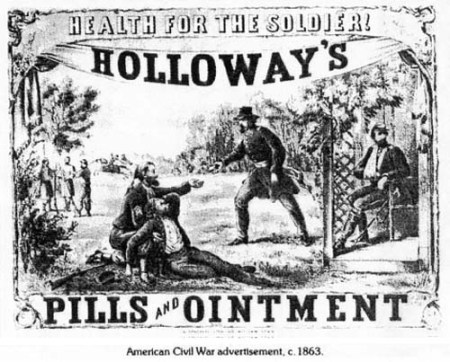
Trade cards exist in the French and German language, and a whole series of other cards exist, such as “Holloway’s Sports & Pastimes of many Nations”, “Holloway’s Natural History” depicting animals, “Indian & Colonial Series”, all extolling the virtues of his pills and ointment.
The uses for both these medicaments went from the sublime to the ridiculous to the dangerous (cures for liver disease, cancer and snake bite). He produced numerous testimonials regarding the efficacy of his products, but there were others who proclaimed him a charlatan and a quack. Two famous detractors were Thomas Wakely (founding editor of ‘The Lancet’) who waged a vigorous campaign against spurious quack medicines such as Holloway’s, as well as an affronted Charles Dickens who refused to accept Holloway’s adverts in any of his books or periodicals.
Holloway’s lasting legacy was the result of his 2 major philanthropic bequests. He was encouraged by Lord Shaftesbury to found a mental hospital and by his wife to found a college for the higher education of women. The Holloway Sanatorium was opened by the Prince and Princess of Wales in 1885 and the Holloway College, was opened in 1886 by Queen Victoria (at which time it acquired the title Royal) and it served as a memorial to his wife Jane (Driver) Holloway, who died in 1875. The Royal Holloway was absorbed into the University of London and is now known as the Royal Holloway at the University of London (RHUL).
Both institutions opened after Thomas died in 1883 before either project was completed, but the composition of a Royal Holloway College Foundation Deed was achieved during his lifetime. I could not find the actual amount of money in the Deed, but he initiated a public debate inviting suggestions as to “How best to spend a quarter of a million (pounds) or more”, an enormous sum in those days. There is an ironic final twist to the Holloway story for it was rumoured that Thomas was trying to gain a knighthood with these gifts, but instead this was bestowed on his brother-in-law, Sir George Martin-Holloway, who brought the Professor’s gifts to fruition.
The assistance and enthusiasm of my fellow Australian, Professor John Courtis, City University of Hong Kong is acknowledged.. Valuable information was supplied by Mark Pitchforth, Archive Assistant, at the Royal Holloway, University of London. This paper is an adaptation of my earlier version published in the Australian Journal of Philately, March 2004, No. 87, pages 5-10.
Addendum: I acquired a Holloway token of the date 1857 and it was very similat to the silver item found in the Encyclopaedia Britannica as shown in Figure 3. The copper token had on the front “Professor Holloway/ London and lower right on the neck was ‘J. MOOR (?E)’ (Figure 8).
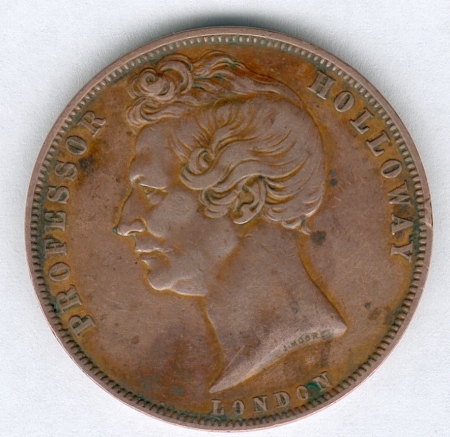
The reverse had Holloway’s Pills and Ointment/ 1857 with a seated ‘Hygeia’ in the centre with ‘J.M.’ at right base (Figure 9).
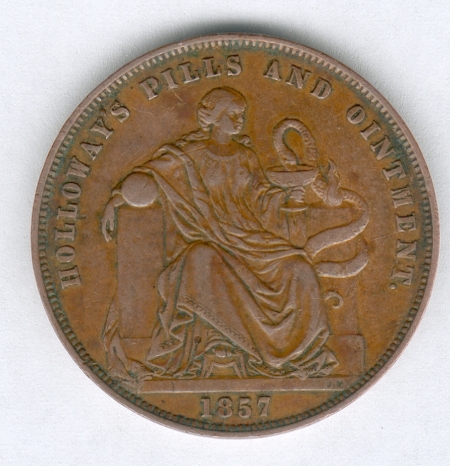
Addendum (August 2007): A similar, but different, “Every Good Nurse” advert praising the Holloway Pills and Ointments cover sent from Rosewood, Queensland to Hobart with two blue 1d ‘figures in four corners’ stamps in 1904 (Figure 10).
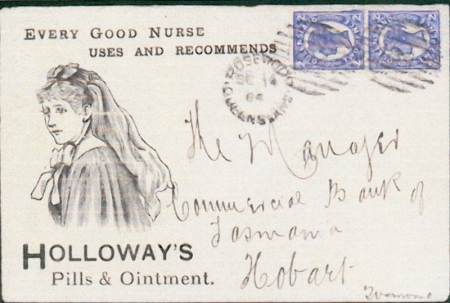
Addendum (August 2009): A correspondent has supplied the following information: I came across your Holloway story while researching family history. Henry Driver-Holloway’s wife Louisa had a cousin Harriet, whose husband Henry Bayly was Deputy PMG in Tasmania in the late 1800s. We know that the two families were in contact from 1870 through to the 1920s. I wonder whether this might help with the Australian connection? Holloway did list himself as professor of medicine in the1861 census, but not 1851 or 1871, when his profession was patent medicine proprietor or vendor. Chris B.
Addendum (November 2009): I continue to be surprised how much more information becomes available. This fine drawing of the Late Thomas Holloway was found in the Illustrated London News, January 5, 1881 (Figure 11).
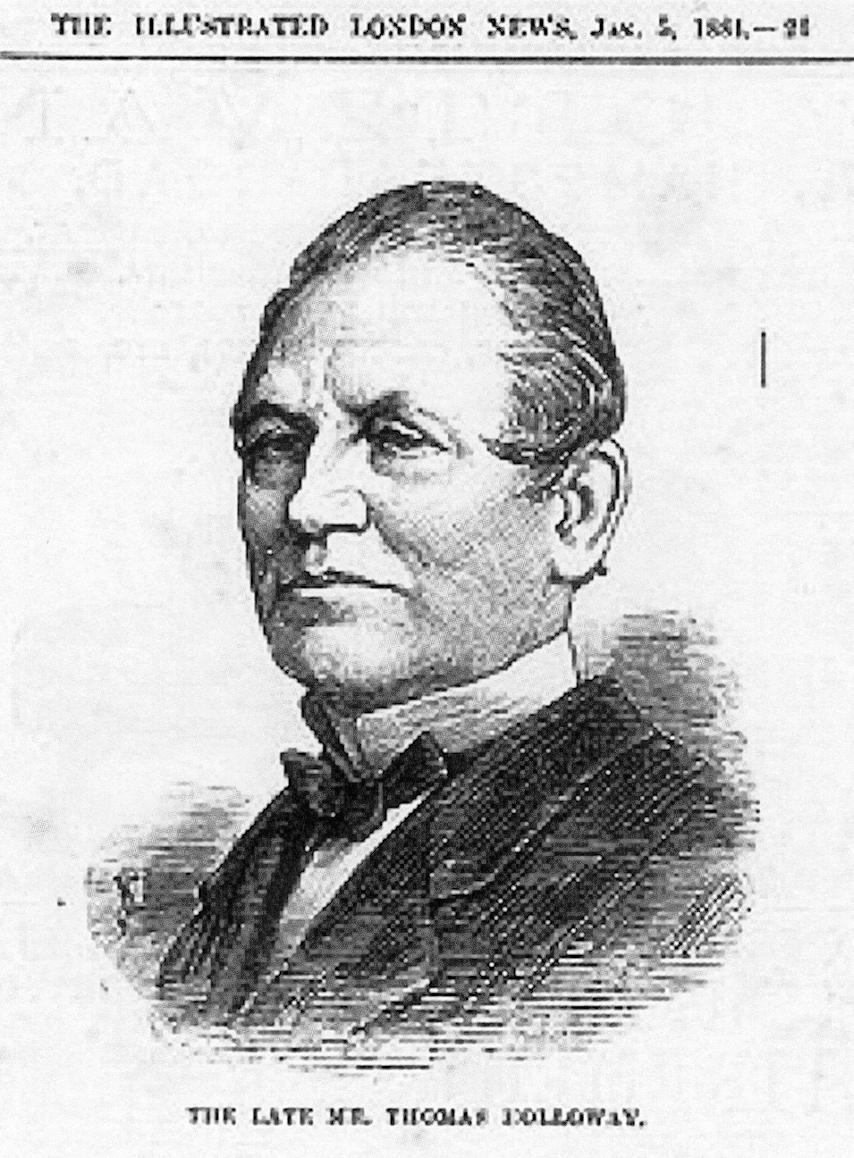
The next two figures attest to the popularity of collecting Holloway Ointment jars of different sizes and designs. One of the jars has an illustration of a mother and baby, the mother may be ‘Hygeia’ (Figure 12).
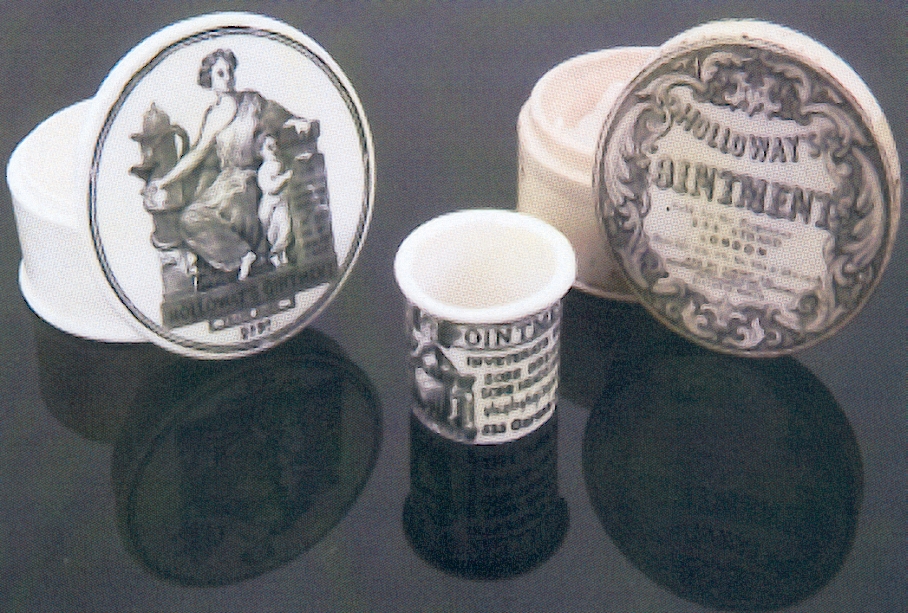
The next jar states that the ointment is used for the Cure of Gout and Rheumatism, and it is prepared only by the Proprietor (Figure 13)
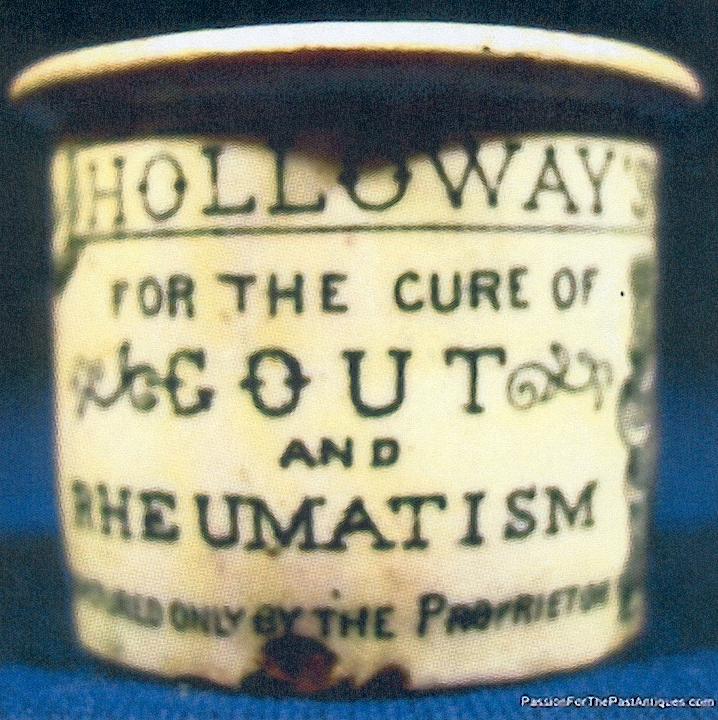
This flamboyant advertisement is entitled Soldier’s True Friend Holloway’s Ointment & Pills and it depicts a woman tending to a wounded soldier (Figure 14).
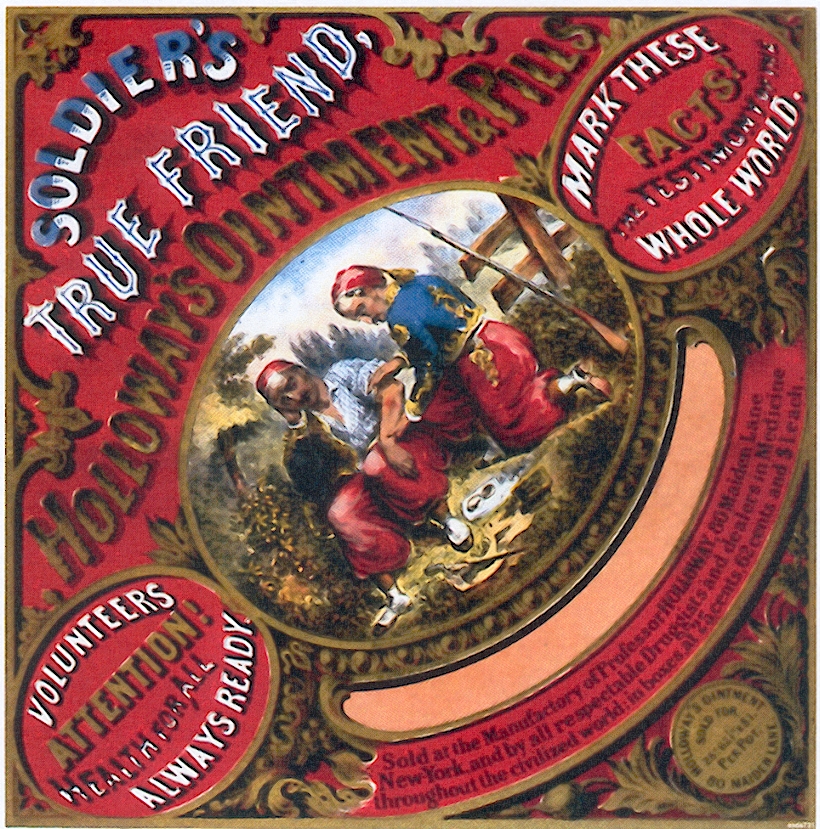
This is a modern reproduction celebrating highlights of Queen Victoria’s reign, with a picture of the Queen and Windsor Castle below (Figure 15).
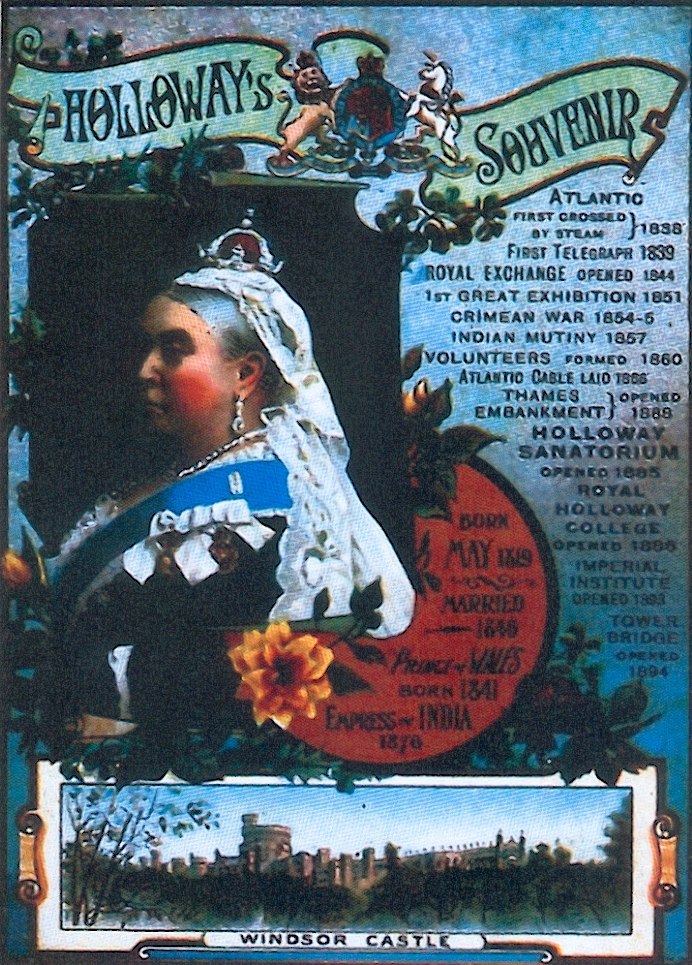
This particularly busy advertisement describes the multiple uses for both the pills and ointment, and it mentions that both are sold by F. Wastie, Chemist at Kennington Cross (Figure 16).

This advertisement was found in the Perth Gazette (W.A.) 12 December 1773, and claims are made for Holloway’s Ointment which stretches one’s imagination. How gullible our recent ancestors were. Perhaps they had read the last 3 lines of the advert, for would a Professor lie to you? (Figure 17).
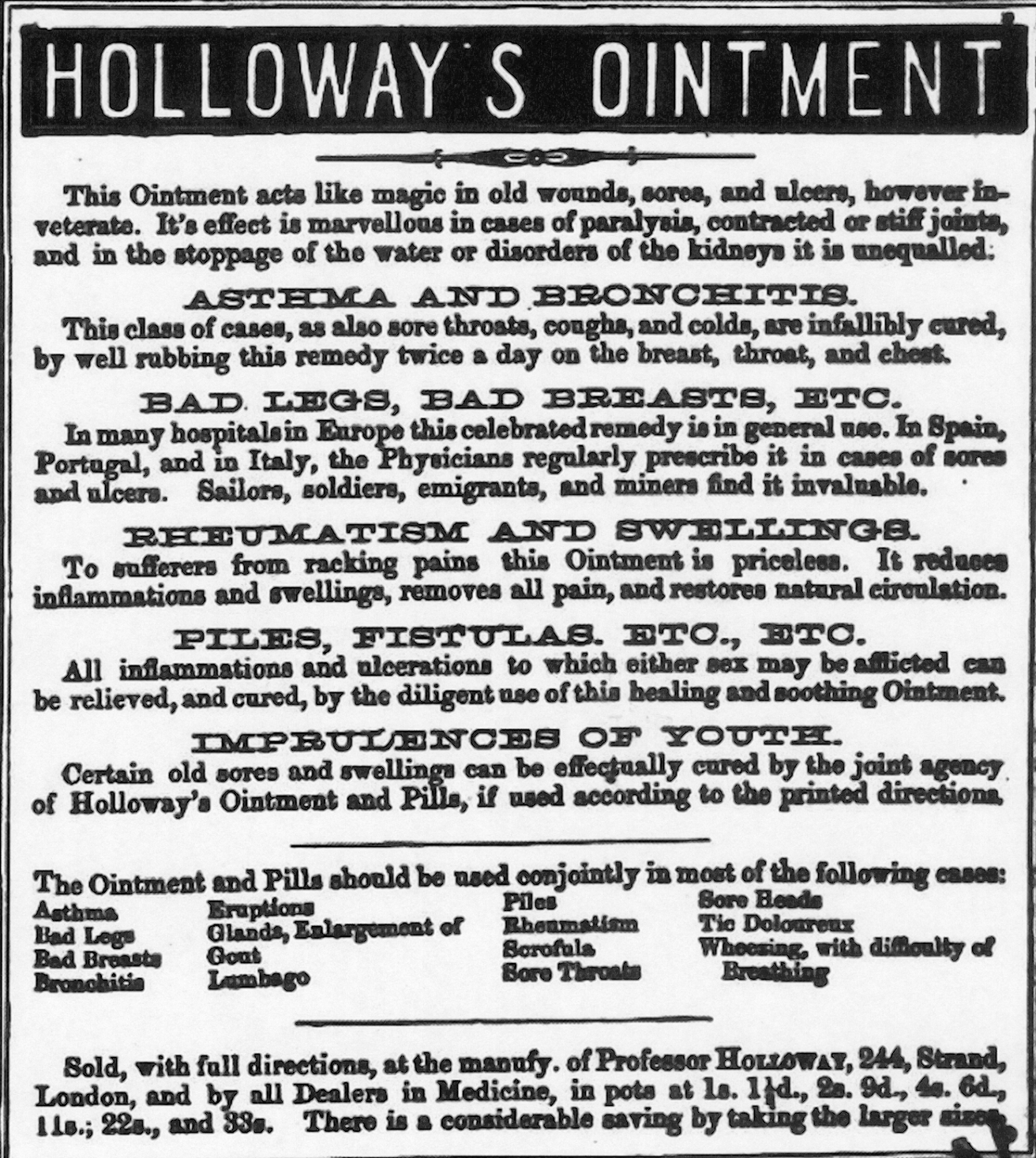
Holloway relied on testimonials (this appeared in the ‘Perth Gazette and Independent Journal of Politics and News’) from patients and this one came from a son of the mother who had suffered from asthma for ‘four and twenty years’. After taking Holloway’s pills, for nine weeks ‘she was perfectly cured, and she now enjoys the best of health, although seventy five years old (Figure 18).
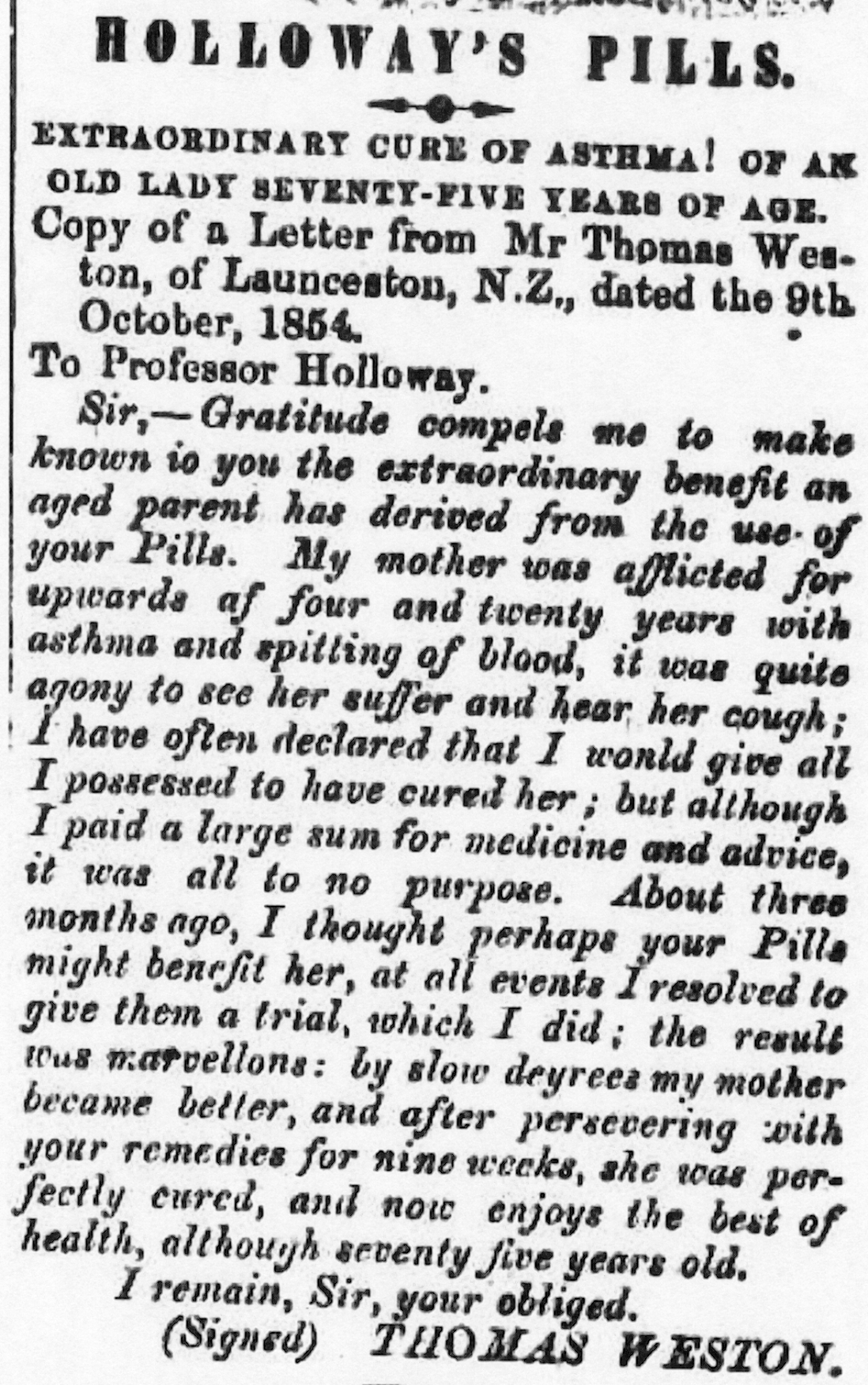
This dark advert has something different from all others seen to date, for he was the master of hyperbole describing his pills and ointment, whereas this mentions and shows pictures of two places built with the Holloway money, the Royal Holloway College on the left and the Holloway Sanitarium on the right. His heart was in the right place, and his wife directed him to philanthropy (Figure 19).
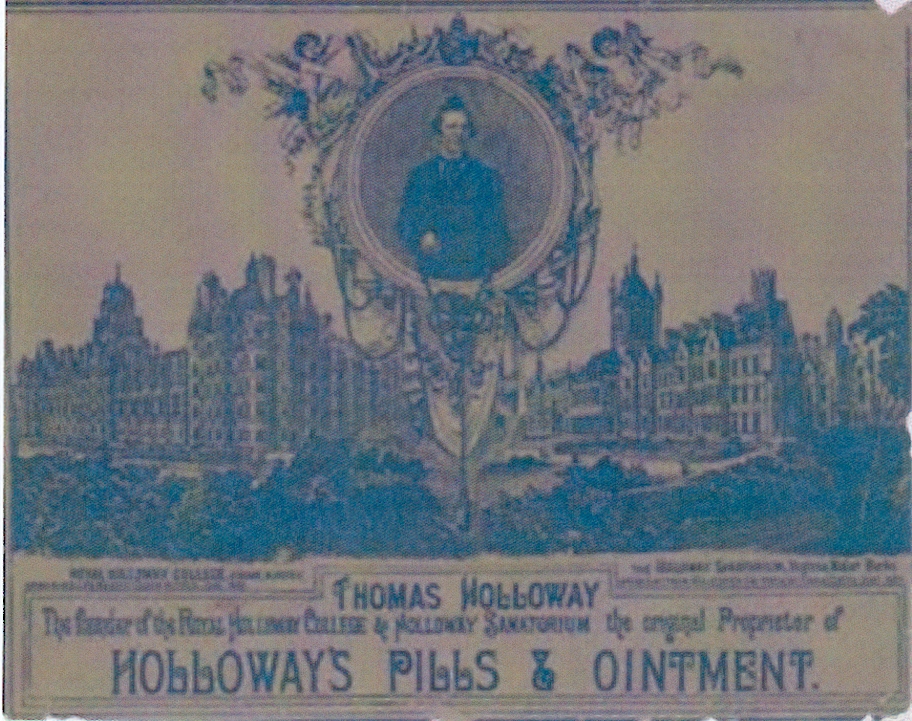
Addendum (October 2010): I have never lost my excitement when I see new Holloway information, and the email and scan sent to me by Jan Kosniowski was of particular interest, coming from such a small place as Trinidad (Figure 20).
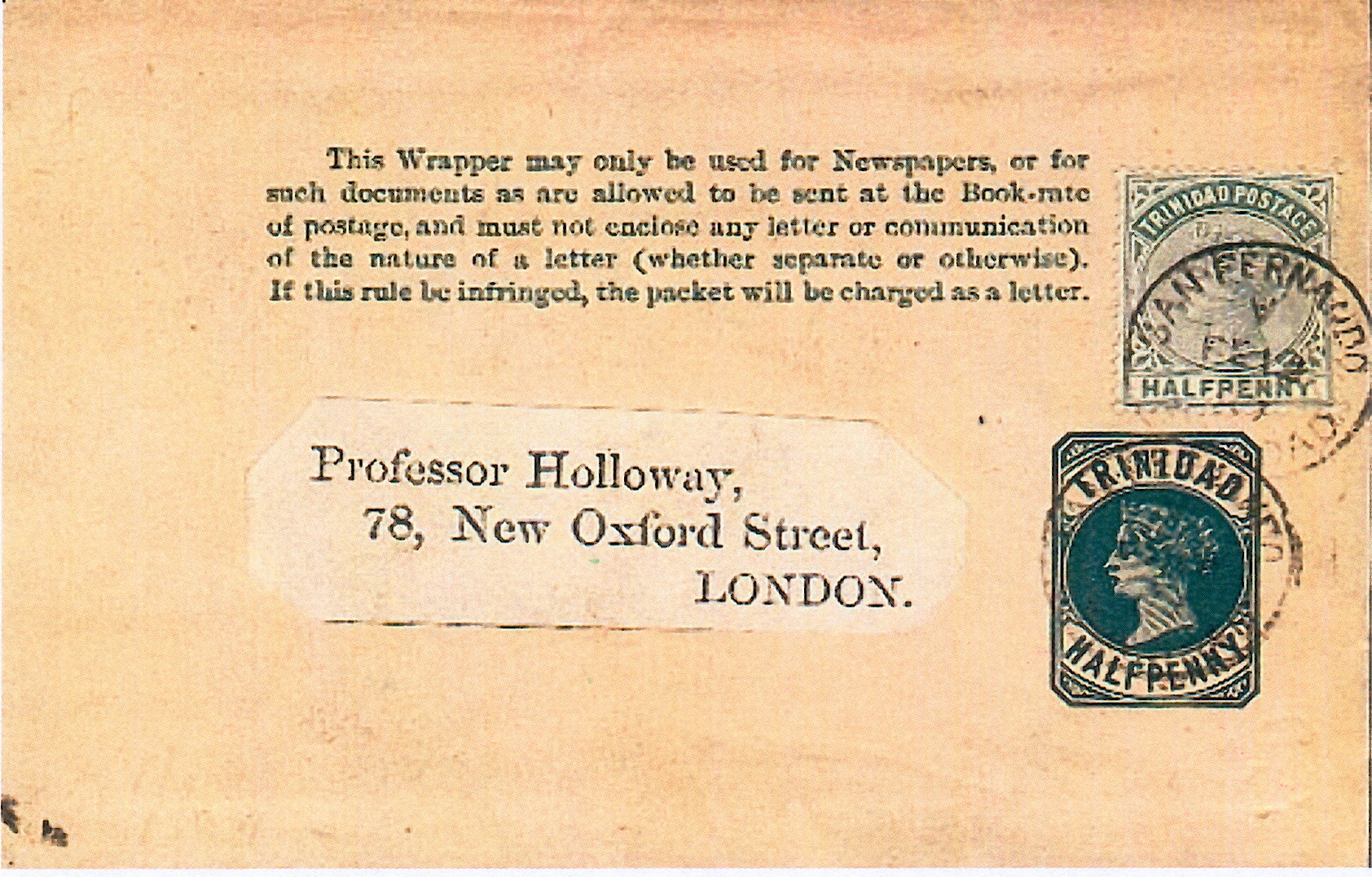
Holloway used several series of postcards, and this Eland card was one of the Natural History Series (Figure 21).
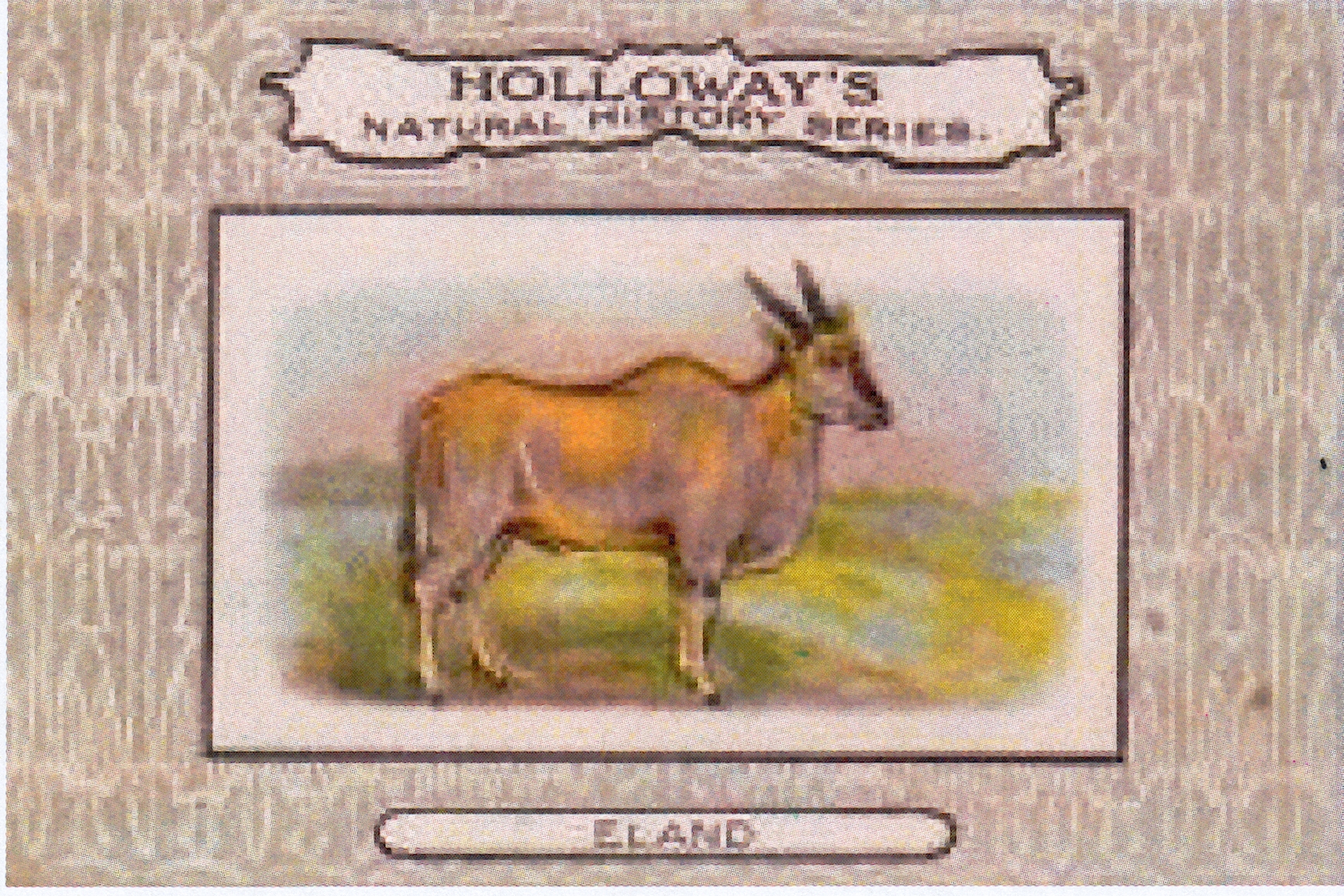
The reverse shows that it is an advert for Holloway pills for a ‘Sick Headache’ (Figure 22).
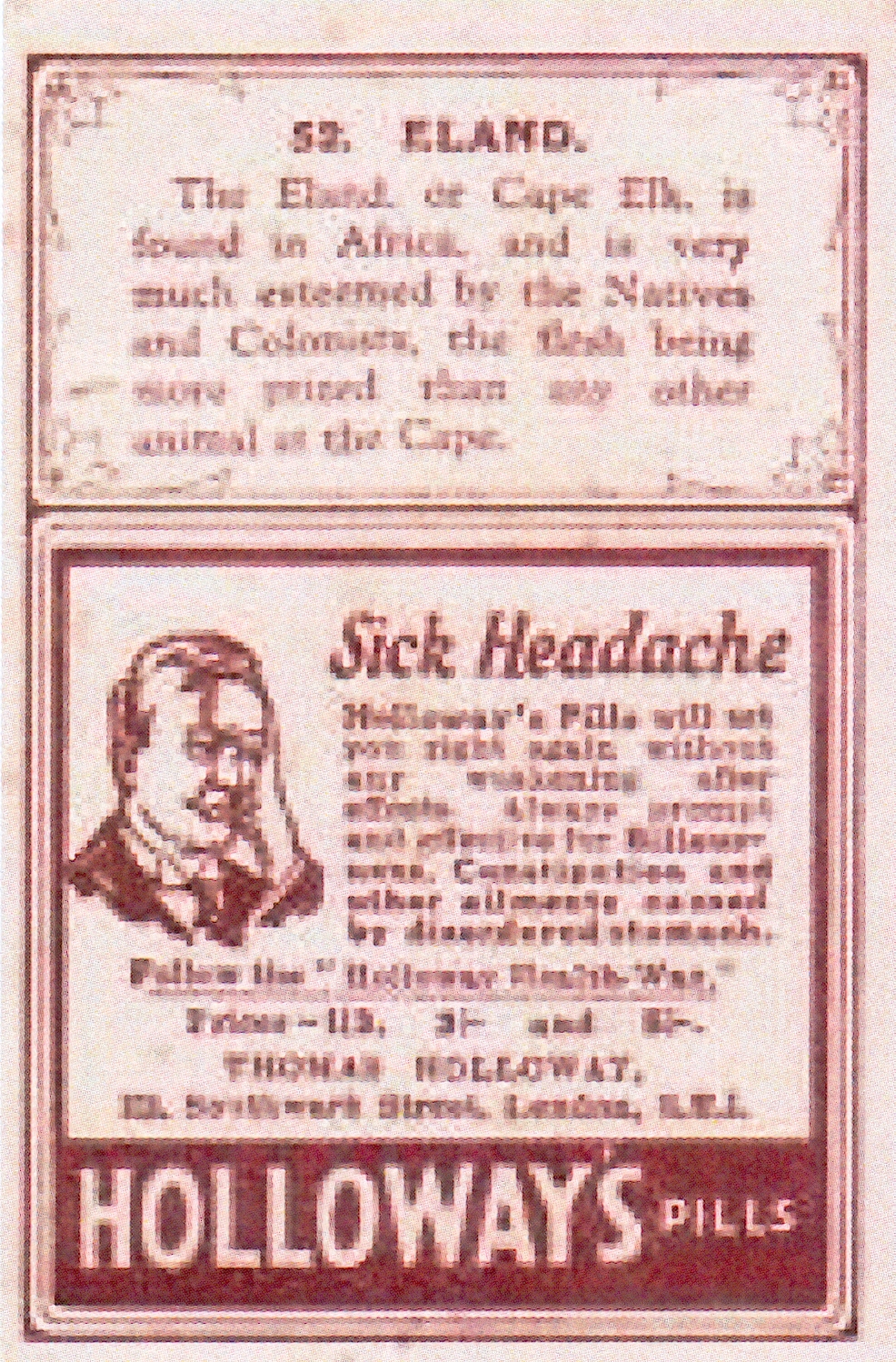
Some additional information was found for “Professor” Holloway: He was the elder son of Thomas and Mary Holloway (nee Chellew), and at the time of his birth ((September 22, 1800) they had a bakery business in Devonport. They later moved to Penzance, Cornwall where they ran the Turk’s Head Inn. In the iate 1820’s, Holloway went to live in Roubaix, France for a few years. He returned to England in 1831, and worked in London as a secretary and interpreter for a firrm of importers and exporters. In 1856 he set himself up as a foreign and commercial agent in London.
Holloway had business connections with an Italian, Felix Albinolo, who manufactured and sold a general purpose ointment. This gave Holloway the idea to set up a similar business himself in 1837. He began by using his mother’s pots and pans to manufacture his ointment in the family kitchen. Seeing the potential in patent medicines, Holloway soon added pills to his range of products. His first newspaper advert appeared in 1837 and by 1842 his yearly expenses for publicity had reached over to £5,000. By the time of his death on December 26, 1883 he was spending over £50,000 a year on advertising, in which he had great faith. He became a multi-millionaire and one of the richest men in Britain at the time. His products were said to be able to cure a whole host of ailments, though scientific evaluation of them after his death showed that none of them contained any ingredients which were considered to be of significant medicinal value.
He bought a Georgian house at Sunninghill, near Ascot, Berkshire called Tittenhurst Park. He lived there with his wife Jane, Jane’s sister Sarah Anne Driver with her husband George Martin, and Anne Holloway’s sister Matilda, an invalid who died soon after. Jane died in 1875, aged 61. Holloway died there of congestion of the lungs on 26th December 1875, aged 83. They are buried in a family grave at Sunninghill Churchyard.
This information was extracted from a book by Anthony Harrison-Barbet, Thomas Holloway: Victorian Philanthropist. ISBN 0-900145-89-7.